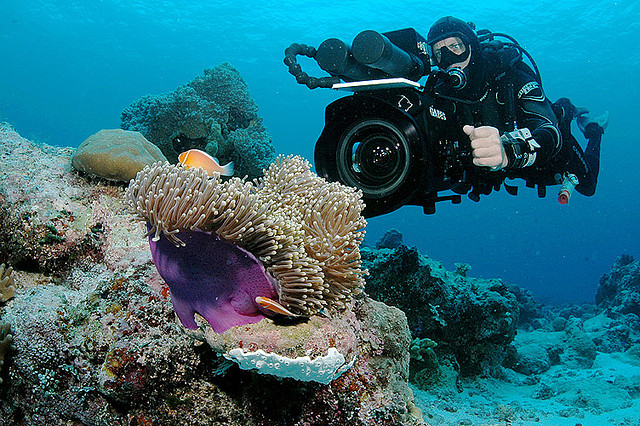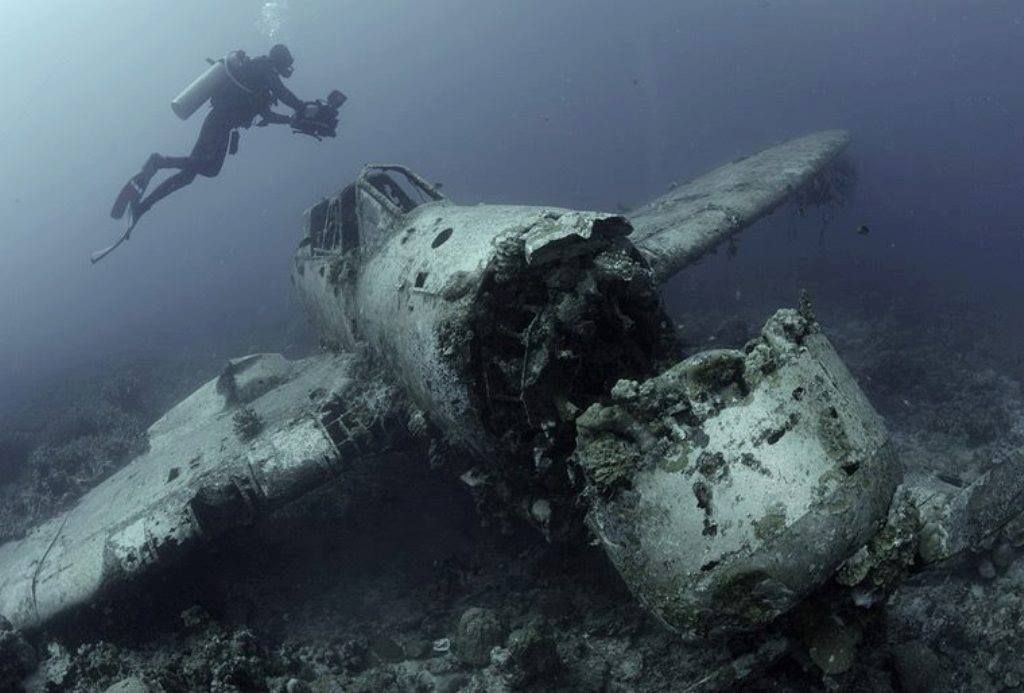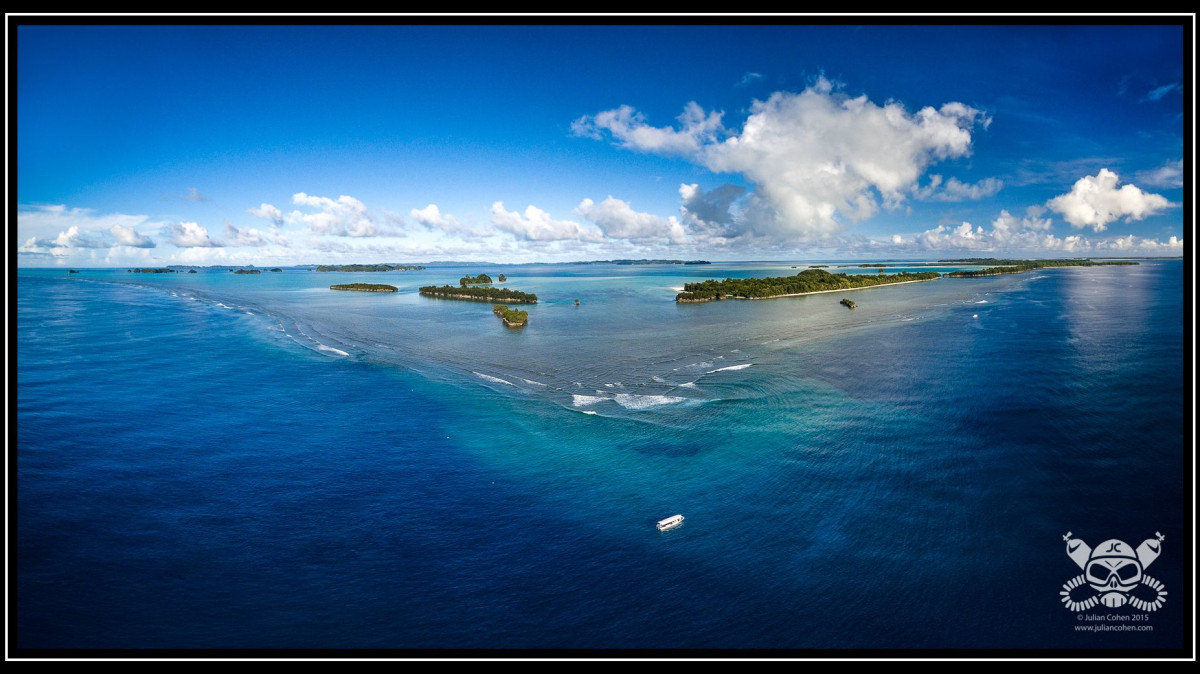Blue Corner, White Knuckles. Pt.1
Diving Palau's Famous Blue Corner Dive Site in a Raging Current? Maybe Not Such a Great Idea!
From my youngest years I'd always been fascinated with images of islands in the Pacific. Verdant jewels fringed with white sandy beaches enveloped in clear, warm and inviting turquoise lagoons. Fast forward to 2001 and I was heading out to the Federated States of Micronesia to start what would be an incredible 8yrs living and diving in some of the most pristine and species diverse waters on Earth. Initially I was heading the tiny island of Yap where stone money was still used for land purchases and other larger transactions. Four years spent on what was known as the Island of Stone Money came to an abrupt halt when, in 2004, Typhoon SUDAL slammed into the island, in fact the worst typhoon to make landfall in some 50yrs, causing incredible damage. I'd spent 4yrs of balmy tropical days spent drifting along reef walls with patrolling sharks, through reef channels filled with majestic Manta Rays and macro critters encountered on night dives that included the incredibly colored Mandarin Fish. Alas it was time to move on, but not far, as I was headed to the neighboring islands of the Republic of Palau. A location lauded by many, myself included, as being potentially the best all round SCUBA Diving location on the Planet.

Filming Anemone Fish in the German Channel Dive Site. Image by Kevin Davidson
Settling into my new location, I'd taken on the imaging concession of one of the more established dive operations on the island, I spent the first couple of months learning the dive sites. Two months to learn the dive sites of Palau? A task I would soon come to realize would easily take a lifetime, or two. So diverse is this location that it caters to all specific areas within SCUBA genres. For sure there are the reefs with a myriad of colorful fish species to enjoy, vertical walls festooned with soft corals that such eminent names as Jacques Cousteau would suggest them as being amongst the best in the World. Adrenalin filled drift dives through reef channels marveling as clouds of Horse Eyed Jacks would deform and reunite as a mix of predators such as Sharks, Dogfish Tuna and Giant Trevally feasted on them. So dense were these schools that these daily onslaughts had little effect on their sheer numbers.

Pushing glass over the wreckage of this Japanese Jake Seaplane in the shallow lagoons close to the commercial hub of Koror. Image by Kevin Davidson
For those looking for something a bit different once they'd had their fix of the reef dives, something I could never really comprehend, Palau had many other options to choose from. Few people know that Palau was also a hiding place for the Japanese navy during WWII. In retaliation to the bombing of Pearl Harbor the Allied Forces found and decimated a fleet of Japanese vessels at rest in the lagoons of Palau. Many of these vessels, and aircraft, are accessible in safe depths for recreational SCUBA activities.
Shallow inner reefs offer numerous locations where macro diving fans could get their fix on all oddities that inhabit these shallower reef systems. For something truly mad Palau is also home to a number of landlocked lakes that host a very special inhabitant, non stinging Jellyfish. In their millions! The most famous of these lakes, funnily enough called Jellyfish Lake, is accessed via a scenic boat ride through the amazing setting that is the Rock Islands of Palau. Limestone rocks worn away at the base due to water erosion give these islands the appearance of green tipped mushrooms that litter the inner reef system of Palau. When the light reflects back from the white sands below the surface the rides around this labyrinth of tropical hues is simply mind blowing.
As our day boats meandered to and from the outer reef dive sites where most of the daily action happened we'd see stingrays, juvenile reef sharks and manta rays escaping our passage. Small man made channels leading to the German Channel dive site would often afford incredible sightings of Manta Rays effortlessly gliding through shallow waters. And then there was Blue Corner!
Blue Corner is probably the signature dive in Palau. It's characterized by a shoulder of coral jutting out from the reef gently sloping off to around 17m where a precipitous reef edge then drops into the abyss. Due to the position of this shoulder of reef it is swept by both incoming and outgoing currents on either side of the sloping shoulder of reef perpendicularly. This in turn creates areas of accelerated current zones as tidal waters seek the easier means of escape up and over the plateau of the reef. If you've ever wanted to see clouds of reef sharks, run the risk of seeing dog toothed tuna bigger than a reef shark or clouds of fish in mating aggregations running the gamut of predators then this is the place. It is a wild and crazy place. And I love every dive I've ever made on it which would be in the 000's.

Blue Corner from the air. The boat in the image is anchored for diving the outgoing tide. The wall beyond the boat being the edge along which divers would deploy reef hooks during incoming tides. Image © Julian Cohen.
The day in question There were only a few of us on the dive boat. We had the well known underwater photojournalist, and personal friend, Douglas Seifert with us at the time. There was one of the local dive guides, one of the best, from the dive shop with whom I was affiliated and also my then squeeze, now wife, Terri. Arriving at the site we thought the marker buoys had been removed as we couldn't see them. We knew the current was going to be high but we never expected just how much! Both of the main marker buoys for the incoming and outgoing entry points for the site had been dragged a good six feet underwater by the current acting on them. This was going to be interesting!
We were looking to enter on the incoming current side to the corner. This meant that there would hopefully be the clouds of Gray Reef Sharks hanging in the currents literally passing inches from our dive masks. Always a great buzz to see on this dive. One thing struck me though. Normally when the currents were passing in said direction the water would be clear as the incoming water would be coming in from the clean outer Ocean. On this day it seemed particularly dull? The sky was blue, no clouds to be seen but the water looked cloudy, for want of a better word. Chomping at the bit and with the visions of what was to be an expected riotous dive we got ready to jump in as a group. Given the elevated current the plan was that two divers on each side of the dive skiff would all backward roll into the water together with empty flotation vests meaning we'd be able to immediately start our kick down descent to the coral plateau below at some 8m.
It didn't happen that way. No sooner had we rolled into the water a comedy of errors played out that would have had any fan of the Keystone Cops in raptures. A comedy that will be divulged in a later blog entry.
To be continued...
"When one man, for whatever reason, has the opportunity to lead an extraordinary life, he has no right to keep it to himself"
Jacques Yves Cousteau
About the Author
Internationally recognized as a provider of quality mixed media Mark Thorpe is always on the search for captivating content.

Photographer / Cameraman
Mark Thorpe
Emmy Award Winning wildlife cameraman and Internationally published landscape photographer Mark Thorpe has been an adventurer since he could walk! Spending 17yrs as an Underwater Cameraman at the start of his imaging career the highlight of which was being contracted to work with National Geographic. In that role as a field producer and cameraman he's been privy to a mixed bag of hair raising adventures. For some reason he was always selected for projects relating to large toothed marine predators such as Great White and Tiger Sharks, Sperm Whales and Fur Seals. Additionally he has also been active within Southern Africa on terrestrial projects dealing with a wide array of iconic wildlife.
Currently based in Okinawa, Japan he's always on the lookout for his next big adventure. He shares his exploits online with a totally organic social audience in excess of 200,000. Sponsored by a number of photographic industry manufacturers he is constantly scouring the islands for captivating landscape and oceanscape compositions. Videography wise he continues to create short photographic tutorial videos as well as creating content about the diversity of wildlife within Okinawa and the Ryukyu Islands of Southern Japan.
Mark has just created a Patreon channel where he's hoping to raise an audience of supporters who through small monthly shows of appreciation will allow him to concentrate on the creation of a wildlife and landscape imaging themed YouTube Channel. If you feel that is something you'd like to support you can visit his Patreon Channel for more information.
